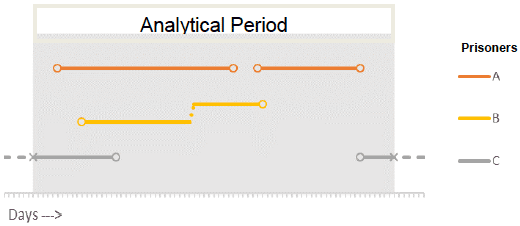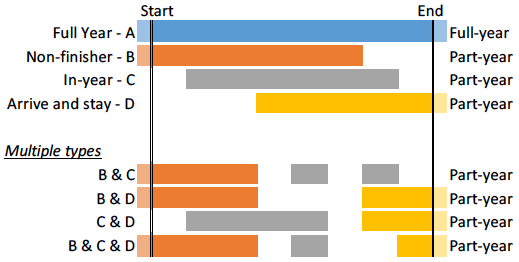Scottish prison population: statistics 2019 to 2020
This publication explores the characteristics of imprisoned people in Scotland. Following several years of sustained decrease, the prison population has risen sharply since 2017-2018 to an annual average of around 8,200 in 2019-2020.
This document is part of a collection
6 Technical Annex
6.1 Determining Prison Occupancy: the "cellwise" method
The most complete record of a prisoner's presence in a prison establishment that is retained in sufficient detail historically on the SPS management information system (known as PR2) is the occupancy by prisoners of specific cells in the estate.
A stint in prison is defined as the period in which a prisoner has an allocated cell (or series of cells) in an SPS establishment. Prisoner A in the diagram below has two stints within an analytical period, represented by the dates that the cell was allocated to them and subsequently de-allocated.
Where a prisoner moves between cells but not between establishments, the stints are combined into a single, continuous period of occupancy in that establishment, as with Prisoner B below. Movements between establishments are kept separately to allow for prison-level analysis of the population.
For statistics within a defined time period (annual, quarterly, monthly), only presence within that period is counted. Prisoner C entered prison before the period began and has two stints. The second stint ends after the analytical period, but days served afterwards are out of scope.

6.1.1 Calculating Daily Averages
A prisoner's occupancy (in days) within an analytical period provides each prisoner with a weight for analysis. For example the average population over a given period across the prison estate is the total number of prisoner days served, divided by the number of days in that analytical period.
When calculating the length of a stint, some edge cases exist: for example when a prisoner enters and leaves prison on the same day. Since the time of entry and exit are not recorded in these data, this would count as zero prisoner days, and therefore zero weight. To account for this, such stints are given a value of 0.25 prisoner days (6 hours) by default.
6.2 Arrivals and Departures
We can identify individuals who begin or end a stint within an analytical period, entering or leaving the care of the Scottish Prison Service. A prisoner arrival is a stint that begins on a separate day from the previous departure for that prisoner.
Prisoners who arrive or depart from the prison estate once or more in an analytical period are by definition the "part-year". Prisoners who do not arrive or depart in an analytical period are the "full-year" group for that period.
The full schema of circumstances that would place a prisoner in either group is provided below. Note that further breaking down the part-year stock by the characteristics of their stints could lead to many additional categories.

The following unusual cases do not remove an individual from the full-year population:
- A prisoner leaves and returns to a prison within the space of the same day (e.g. to visit court, make a short visit to a hospital, attend a family funeral, etc.)
- A prisoner leaves one prison and arrives at another Scottish prison within the space of a day, i.e. a prisoner transfer
6.3 Recorded Liberations
When a prisoner leaves prison and is not expected to return under the same legal basis, their liberation is recorded on the SPS management information system.
We have made a distinction here between "departures" - defined as a stint in prison ending and not immediately followed by a further stint - and "liberations", where an individual has finished their period in custody and is released. A person in prison can have multiple departures and liberations within a year if they are released for short periods but subsequently return. Where a departure coincides with a Liberation record (+/- 1 day) that departure is counted as a Liberation. Where no Liberation is available, they are simply counted as departures.
People may leave prison without a liberation being recorded if their absence is temporary, for example if they are on leave to return home for a night or more. In these cases no liberation is recorded - the prisoner is still under the authority of the Scottish Prison Service. These "non-liberation departures" are relatively few each year (1-2% of departures).
If a liberation record does not coincide with a departure, it is not included in these statistics. Similarly liberations to court are not included here - they generally occur in the middle of a stint in prison, after which a person would return to prison at the end of the day.
Table 4: Liberation types
Liberation Type: Interpretation
Sentence Served: The individual has reached their earliest date of liberation from their sentence and has been released
HDC: Home Detention Curfew - the prisoner serves the remainder of their sentence subject to specific conditions, including the wearing of an electronic monitoring tag
Bailed: A person on remand returned to court and was released pending further court attendance
On licence/Parole/SRO: A person returns to their community under a specific set of conditions. Breach of these conditions can lead to a return to prison
Immigration/Deportation: A person is removed from the country, removed to Dungavel Detention Centre, or leaves Scotland on the Early Removal Scheme
Fine Paid: A person imprisoned for non-payment is released after paying their fine
Lib To Mental Hosp: A person is moved to a psychiatric hospital ward
Appeal/Pardon: A person has their sentence overturned
Other: All other liberation types
People who have died in prison are counted in the "Other" category above. Deaths in custody are the subject of Scottish Prison Service reporting, available on the SPS website: https://www.sps.gov.uk/Corporate/Information/PrisonerDeaths.aspx
6.4 Postcode Quality
SPS is in the process of working backwards through prisoner records to improve the quality of postcode information held on PR2 in collaboration with data officers at the individual establishments across the prison estate.
One of the steps being taken is to apply the postcode of Council offices to people with no fixed abode. This process is currently incomplete, however future data releases will be able toinclude people of no fixed abode in the Local Authority disaggregated statistics.
Aside from records for prisoners of no fixed abode, many postcodes remain incomplete and therefore unmatchable to broader geographic characteristics. A further data improvement exercise by PR2 system administrators is in train, and the number of postcodes which cannot be matched is likely to fall as this proceeds.
The records marked as being "Address Outwith Scotland" leverage information from the "country" part of the address data where the supplied postcode cannot be matched. This group includes only records where the country is recorded as specific administrations in the UK (England, Wales, Northern Ireland) or non-UK countries, but does not include those cases where the country is given as "UK", i.e. unspecified. Cases with unmatchable postcodes and where the country provided is either Scotland or is unspecified are gathered together under the "Unknown Address" category.
| Financial Year | Total Arrivals | Known LA | No Fixed Abode | Unknown Address | Address Outwith Scotland |
|---|---|---|---|---|---|
| 2010-11 | 20,721 | 19,176 | 915 | 615 | 15 |
| 2011-12 | 20,958 | 19,305 | 947 | 696 | 10 |
| 2012-13 | 19,071 | 17,547 | 899 | 610 | 15 |
| 2013-14 | 19,306 | 17,759 | 976 | 558 | 13 |
| 2014-15 | 18,540 | 16,958 | 1,002 | 557 | 23 |
| 2015-16 | 17,905 | 16,260 | 1,069 | 527 | 49 |
| 2016-17 | 16,446 | 14,861 | 994 | 527 | 64 |
| 2017-18 | 15,324 | 13,813 | 980 | 480 | 51 |
| 2018-19 | 15,595 | 14,095 | 997 | 413 | 90 |
| 2019-20 | 14,324 | 12,825 | 1,072 | 129 | 298 |
Total Arrivals: The number of times someone arrives in prison in the period. Includes counting of multiple arrivals per person.
Known LA: The postcode provided by the person arriving in prison matches a known address in Scotland, allowing the derivation of further geographical information
No Fixed Abode: The person self-identifies as have no fixed abode on entry to the prison
Unknown Address: A postcode has been provided which cannot be matched.
Outwith Scotland: A postcode has been provided which cannot be matched and the individual has supplied the country of their address as being outwith Scotland
Contact
Email: justice_analysts@gov.scot
There is a problem
Thanks for your feedback